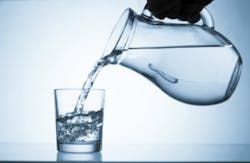Q: How much water should people drink, and how much do they actually drink every day?
A: It is complicated. The amount of water that is needed for health and homeostasis varies by a person’s age and weight, climate and his/her level of physical activity. Some estimates and recommendations have been generated from several published studies.
Introduction
The statement, "Water is life," is not an exaggeration. All living plants and animals require regular and sufficient water consumption for survival, as well as for growth and development. Serious and even fatal outcomes can occur under extreme conditions of either seriously inadequate or very excessive water intake, and there might be some health benefits associated with consumption beyond the averages. Water is also a common element in Christian, Muslim and Jewish religious writings.
Daily water consumption occurs from several sources: Tap water, beverages and foods made with tap water, bottled water, bottled beverages and metabolic water that is produced from ingested food and its conversion to energy. The first four are obvious. The fifth, metabolic water, is created by living organisms through metabolism by digesting and oxidizing energy-containing substances in their food. Metabolism produces about 110 grams of water per 100 grams of fat, 41.3 grams of water per 100 grams of protein and 55 grams of water per 100 grams of starch. So, it adds a few hundred milliliters to our daily water intake.
How much water should we drink?
Ingested water serves many functions. It is essential for maintaining blood composition, salts balance and cellular osmotic pressure, and it aids digestion, helps eliminate wastes in urine and feces, provides a solvent/solute load for the kidneys and helps control body temperature through perspiration. It usually contains salts and some nutrients like calcium, magnesium, chloride, sulfate, sodium and potassium; and, uptake of essential minerals is often more efficient from water than from foods. Calcium and magnesium uptake from water and milk is in the range of 50 to 60 percent versus approximately 15 to 20 percent from foods.
It is important to consume water regularly, especially during physical stress conditions. I recall when coaches would not allow athletes to consume water during practice and games, ostensibly to prevent vomiting. Nowadays, we see them drinking constantly. Acute dehydration has immediate, measurable and adverse consequences. Fluid loss of one percent stimulates thirst and impairs thermoregulation. Vague discomfort and loss of appetite appears at two percent. Dry mouth appears at about three percent loss. At four percent loss, work capacity decreases by 20 to 30 percent. Headaches and sleepiness occur at about five percent loss. Collapse can occur at about seven percent, and a 10 percent loss is life-threatening.
Water intake is needed at a minimum to replace losses and prevent dehydration. Water is lost through urine, feces, respiration and evaporation. Young children, pregnant and lactating women, the elderly, heavy work and exercisers and persons with certain diseases have increased fluid requirements compared to the general sedentary population. Numerous studies have attempted to determine water needs, but in 1989 the National Research Council (NRC) concluded that because of the complexities, a Recommended Dietary Allowance (RDA) could not be established, but an Adequate Intake (AI) reference value was provided for healthy Canadian and American populations.
Water needs under conditions of physical stress, high temperature and humidity are substantial. Physically active individuals might sweat at the rate of three to four liters per hour under those conditions. Daily fluid requirements have been shown to range from as little as two liters per day to 16 liters per day. Several national military organizations have conducted studies of the water needs of troops under stressed survival and endurance requirements. A study of members of the Zimbabwe National Army doing strenuous work over 12 days showed that consumption of the test group was 11 liters per day versus seven liters per day in the control group.
The U.S. Army revised its water replacement guidelines to 0.5 liters per hour for an easy work rest cycle at 78o to 81.9o F to at least one liter per hour for a hard work/rest cycle of 10/50 minutes at > 90o F. The revision occurred after 190 military personnel were hospitalized over several years for hyponatremia (excess, unreplaced sodium loss by perspiration), which can be fatal when excessively large volumes of plain water were consumed in combination with a low sodium chloride diet.
Gender and age specific AIs were established by the NRC in 2004 (See Table 1).
Table 1
| Age | AI (l/day) |
| Zero to six months | 0.7 assumed from human milk |
| Seven to 12 months | 0.8 milk plus food and beverages |
| One to three years | 1.3 |
| Three to eight years | 1.7 |
| Nine to 13 years | 2.4 boys, 2.1 girls |
| 14 to 18 years | 3.3 boys, 2.3 girls |
| 19 to 70+ | 3.7 men, 2.7 women |
The values in Table 1 are applicable under typical, nonstressed conditions. For higher stress situations (e.g., athletes), the amount of water ingested should equal the amount lost, i.e., 1 kg of lost weight = 1 kg of water consumption. Alcohol has a known transient diuretic effect, but adequate fluid intake immediately following alcohol consumption will not result in appreciable fluid losses over a 24-hour period.
The World Health Organization’s (WHO) requirements in liters per day for adults are listed in Table 2.
Table 2
| Sedentary, temperate env. | Physically active/increased temperature | |
| Female adult | 2.2 | 4.5 |
| Male adult | 2.9 | 4.5 – 11.0 |


